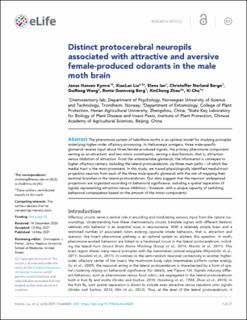| dc.contributor.author | Kymre, Jonas Hansen | |
| dc.contributor.author | Liu, Xiaolan | |
| dc.contributor.author | Ian, Elena | |
| dc.contributor.author | Berge, Christoffer Nerland | |
| dc.contributor.author | Wang, Guirong | |
| dc.contributor.author | Berg, Bente Gunnveig | |
| dc.contributor.author | Zhao, Xincheng | |
| dc.contributor.author | Chu, Xi | |
| dc.date.accessioned | 2021-09-28T12:57:08Z | |
| dc.date.available | 2021-09-28T12:57:08Z | |
| dc.date.created | 2021-05-14T19:01:28Z | |
| dc.date.issued | 2021 | |
| dc.identifier.issn | 2050-084X | |
| dc.identifier.uri | https://hdl.handle.net/11250/2784139 | |
| dc.description.abstract | The pheromone system of heliothine moths is an optimal model for studying principles underlying higher-order olfactory processing. In Helicoverpa armigera, three male-specific glomeruli receive input about three female-produced signals, the primary pheromone component, serving as an attractant, and two minor constituents, serving a dual function, that is, attraction versus inhibition of attraction. From the antennal-lobe glomeruli, the information is conveyed to higher olfactory centers, including the lateral protocerebrum, via three main paths – of which the medial tract is the most prominent. In this study, we traced physiologically identified medial-tract projection neurons from each of the three male-specific glomeruli with the aim of mapping their terminal branches in the lateral protocerebrum. Our data suggest that the neurons’ widespread projections are organized according to behavioral significance, including a spatial separation of signals representing attraction versus inhibition – however, with a unique capacity of switching behavioral consequence based on the amount of the minor components. | en_US |
| dc.language.iso | eng | en_US |
| dc.publisher | eLife Sciences Publications | en_US |
| dc.rights | Navngivelse 4.0 Internasjonal | * |
| dc.rights.uri | http://creativecommons.org/licenses/by/4.0/deed.no | * |
| dc.title | Distinct protocerebral neuropils associated with attractive and aversive female-produced odorants in the male moth brain | en_US |
| dc.type | Peer reviewed | en_US |
| dc.type | Journal article | en_US |
| dc.description.version | publishedVersion | en_US |
| dc.source.volume | 10 | en_US |
| dc.source.journal | eLIFE | en_US |
| dc.identifier.doi | 10.7554/eLife.65683 | |
| dc.identifier.cristin | 1910110 | |
| dc.relation.project | Norges forskningsråd: 287052 | en_US |
| cristin.ispublished | true | |
| cristin.fulltext | original | |
| cristin.qualitycode | 2 | |

